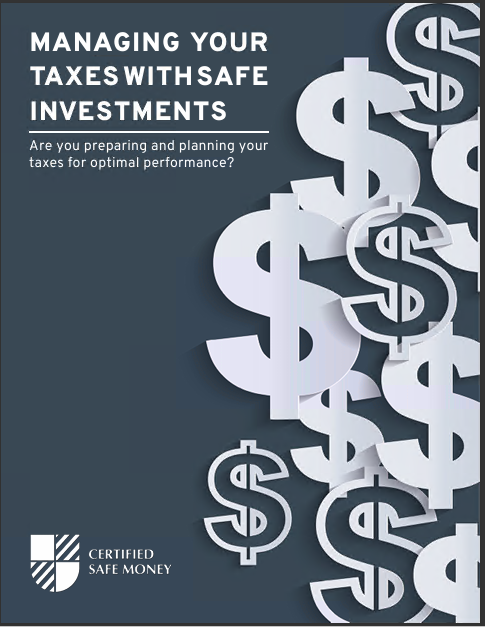Key Takeaways
-
Understanding how MYGAs (Multi-Year Guaranteed Annuities) interact with taxes can save you from unexpected financial hits down the road.
-
Tax advantages depend on how you structure your MYGA investment, so it’s crucial to grasp the nuances before you invest.
Why Taxes and MYGAs Should Be on Your Radar
If you’re considering safe-money investments, you’ve likely heard about Multi-Year Guaranteed Annuities (MYGAs). They’re appealing because they offer fixed returns for specific durations, typically ranging from 3 to 10 years. But there’s a catch—taxes. Ignoring tax implications can cost you significantly. Let’s explore five key insights you need to understand about taxes and MYGA investments.
1. How Exactly MYGA Earnings Get Taxed
Before jumping into MYGAs, it’s vital to understand how the earnings are taxed because it’s different from other investment types.
Earnings Grow Tax-Deferred
With MYGAs, your money grows tax-deferred. This means:
-
You won’t pay taxes each year on your gains.
-
Taxes only kick in when you withdraw your money.
-
You benefit from compound growth since you’re not losing annual earnings to taxes.
Ordinary Income Tax Rates Apply
When you eventually withdraw money, the gains are taxed at your ordinary income tax rate—not the lower capital gains rate. Depending on your tax bracket at withdrawal time, this could significantly impact your returns.
Penalties for Early Withdrawal
Taking money out of your MYGA before age 59½ can result in a hefty 10% early withdrawal penalty on the earnings. It’s crucial to keep this in mind when planning your investment timeline.
2. The Importance of Contract Length
When you purchase a MYGA, you choose a contract duration upfront, typically ranging from 3 to 10 years. Understanding the length of the contract helps you better manage your tax situation.
Short-Term Contracts (3–5 Years)
-
Provide flexibility if you foresee needing cash soon.
-
Allow easier adjustment to changing tax brackets.
Long-Term Contracts (7–10 Years)
-
Typically offer higher guaranteed interest rates.
-
Ideal for locking in rates if you anticipate future tax rate increases.
Your choice directly influences your tax planning strategy. For instance, shorter contracts give you more frequent control over your tax liabilities, while longer durations help secure stable earnings but require more precise tax forecasting.
3. Withdrawal Strategies to Minimize Taxes
Smart withdrawal strategies can significantly reduce your tax burden when the time comes.
Systematic Withdrawals
Spreading out withdrawals over several years keeps you from jumping into a higher tax bracket unexpectedly. You might consider annual, smaller withdrawals rather than one large lump sum.
Laddering Strategy
Another approach is laddering MYGAs:
-
Invest in multiple MYGAs with varying maturity dates.
-
Each MYGA matures at a different time, allowing you to strategically time withdrawals based on your expected tax situation.
Laddering helps avoid large taxable gains in a single tax year, providing flexibility and tax efficiency.
Qualified vs. Non-Qualified Annuities
MYGAs come in two varieties:
-
Qualified MYGAs are funded with pre-tax dollars (like an IRA). Taxes are due on the entire withdrawal amount.
-
Non-Qualified MYGAs are funded with after-tax dollars. Taxes apply only to the earnings portion upon withdrawal.
Choosing between these depends on your current and future expected tax brackets, retirement plans, and financial goals.
4. Beneficiary Considerations and Tax Implications
Considering who inherits your MYGA and the associated taxes can significantly impact estate planning.
Spousal Beneficiaries
If your spouse inherits your MYGA:
-
They may continue the annuity under their name.
-
The tax-deferred growth continues uninterrupted.
-
No immediate tax consequences.
Non-Spousal Beneficiaries
If your beneficiary isn’t your spouse:
-
They must typically withdraw the funds within 5 years or choose periodic distributions.
-
Distributions are taxable as ordinary income.
Strategic estate planning with your beneficiaries can help minimize their tax burden significantly, ensuring your loved ones benefit fully from your thoughtful investment.
5. State Taxation and Its Impact on MYGAs
Most investors overlook state-level taxation, but it can notably affect your net returns.
State Income Tax
State taxes vary dramatically:
-
Some states have no income tax, offering significant savings.
-
Others tax annuity earnings aggressively, reducing your actual gains.
Consider your state’s income tax policies carefully, especially if you’re considering moving during or after your investment period.
Planning for State Changes
If relocation is part of your retirement strategy, timing withdrawals based on your resident state’s tax rules can make a substantial financial difference. Planning ahead to withdraw funds when you’re living in a state with lower or no income taxes maximizes your returns.
Practical Steps Before Investing
Before finalizing your MYGA investment, follow these practical steps to safeguard your returns from unexpected tax liabilities:
-
Consult a Tax Advisor: Always get personalized advice on your specific financial situation.
-
Understand the Contract Terms: Clarify maturity periods, withdrawal penalties, and guarantees.
-
Create a Withdrawal Plan: Develop a tax-efficient withdrawal strategy well before the contract maturity.
-
Check State Tax Rules: Know your current state’s rules and any potential state you may move to.
Taking these proactive steps ensures you’re not just investing safely but smartly, keeping more of your money where it belongs—in your pocket.
Bringing It All Together for a Safe and Smart Investment
Understanding the intersection between taxes and MYGA investments can be the difference between meeting your financial goals comfortably or facing unforeseen tax hits. By paying close attention to how your earnings are taxed, choosing the right contract lengths, using strategic withdrawal methods, preparing for beneficiary implications, and carefully considering state taxes, you’ll ensure that your safe-money investment delivers the peace of mind you seek.
Tax planning isn’t just about minimizing liabilities; it’s about maximizing your hard-earned investment returns safely and reliably. MYGAs are a powerful tool in your financial toolkit—just make sure you wield them wisely!










